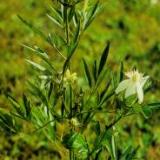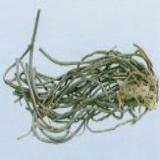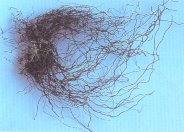Clematis Root
http://www.100md.com
《e Natural Health Center》
 |
 |
 |
 |
Anti-rheumatics for Dispersing Cold
Clematis Root
Latin:
Radix clematidis
Origin:
The root or rhizome of Clematis chinensis Osbeck (Chinese clematis), Clematis hexasegmenta Pall. (six-segment clematis) or Clematis manshurica (Manchurian clematis), a climbing shrub, of the family Ranunculaceae. In China, the former one is mainly produced in the provinces Jiangsu, Anhui, Zhejiang, etc., and more extensively used, while the latter two are used in some areas.
, 百拇医药
Clematis is a group of vining plants. Clematis means climbing. Some species have large and showy flowers while others are fairly small. This genus grows in open woods, hedges, thickets, roadsides and banks of streams in various parts of the world.
A decidious climber, it grows to about 5 m by 5 m. It is in flower from September to October, and the seeds ripen from October to November. The flowers are hermaphrodite (have both male and female organs) and are pollinated by bees and flies. The plant can grow in semi-shade (light woodland) or no shade. It requires moist soil.
, 百拇医药
The herb is harvested in autumn. Remove sand and earth from the root, dry it in the sun and use it when raw.
Properties:
Pungent and salty in flavor, warm in nature, it is related to the urinary bladder channel.
Functions:
Dispels pathogenic wind and dampness, clears and activates the channels and collaterals and removes bone jamming.
, 百拇医药
The root is anodyne (relieves pain or discomfort), antidote (counteracting poison), antiperiodic, antispasmodic, carminative (expelling gas from the alimentary canal so as to relieve colic or griping), diuretic and sedative.
The whole plant is antirheumatic. The plant also has a history of folk use in the treatment of cancer.
Applications:
1. To treat arthralgia due to pathogenic wind-dampness:
, http://www.100md.com
The clematis root can be used alone by being ground into powder and mixed with warm wine or made into pills together with Chinese angelica and cassia bark, e.g., Shen Ying Wan, for oral administration. In most cases, it is now used together with notopterygium root or rhizome, fangfeng (Radix Ledebouriellae), chuanxiong (Rhizoma Ligustici Chuanxiong), turmeric (Rhizoma Curcumae Longae), etc.
2. To treat bone jamming or fishbone in the throat:
, 百拇医药
This herb can be used alone or decocted with the addition of sugar and vinegar, and swallowing the decoction slowly can generally eliminate the bone jamming or sticking.
Dosage and Administration:
5-10 g.
Decoct this herb for oral administration.
Cautions on Use:
This species is harmful if eaten raw. The toxic substances is dissipated by heat or by drying.
, http://www.100md.com
The plant is also a mild skin irritant.
Reference Materials:
'Kai Bao Materia Medica' :
"Various wind syndromes, long accumulation of phlegm and fluids in the hypochondria and epigastrium, various masses in the hypochondria and abdomen, retention of pus and deteriorated fluid in the urinary bladder, cold pains in the loins and knees and fractures and traumas."
, http://www.100md.com
"Removing obstruction from and activating the five fu-organs and eliminating cold-qi from the abdomen."
'Explanations of Drugs' :
"With its fierce and swift properties, the potency of the clematis root tends to run instead of staying to remove obstruction from and activate 12 channels and collaterals."
"Migratory arthralgia or arthritis and bone and joint pains or swelling or numbness due to the stagnation of pathogenic wind, dampness or phlegm in the channels and collaterals."
, http://www.100md.com
Toxic or Side Effects:
Slightly toxic.
Modern Researches:
The clematis root contains anemonin, anemone saponin, etc.
Anemonin has antibacterial, analgesic (removes pain), sedative and antispasmodic actions. It also inhibits the heart and central nervous system and is rubefacient (produces redness of the skin).
Its decoction has an obvious antibacterial effect and a rather powerful inhibitory effect on Gram-positive and Gram-negative bacteria and moulds.
Its vinegar immersion has a certain softening effect on fish bones and it can relax local muscles, causing jammed bones to fall off., http://www.100md.com